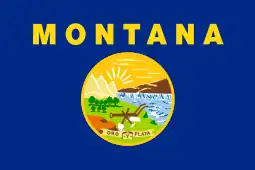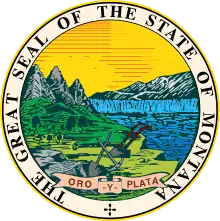Montana State Government
As established and defined by the Montana Constitution, the government of the State of Montana is composed of three branches, the Executive, Judicial, and Legislative. The powers of initiative and referendum are reserved for the citizens of Montana.


The second and current state constitution was enacted in 1972.[1] Among its changes, it stipulated that all Montanans' access to their government is a constitutionally protected right, and it includes the right to examine documents or to observe the deliberations of all public bodies or agencies of state government and its subdivisions.[2]
Legislative Branch
Like the federal government and 48 other states, Montana has a bicameral legislature composed of two chambers, a 100-member House of Representatives and a 50-member Senate. Legislators are elected by popular vote. As of 1992 term limits were enacted limiting House members to four 2-year terms, and Senate members to two 4-year terms. The Montana State Legislature convenes only on odd-numbered years, and for 90-day periods. In addition, state law allows for the legislature to be convened in special session by the governor or at the written request of a majority of the members. As of 2005, the Montana Legislature has been convened in special session thirty times in its history.[3]
Executive branch
The daily administration of the state’s laws, as defined in the Montana Code Annotated, are carried out by the chief executive—the Governor, and their second in command the Lieutenant Governor, the Secretary Of State, the Attorney General, the Superintendent of Public Instruction, the State Auditor, and by the staff and employees of the 14 executive branch agencies.
Acknowledging the importance of providing for an orderly arrangement in the administrative organization of state government, the number of principal departments from which all executive and administrative offices, boards, bureaus, commissions, agencies and instrumentalities of the executive branch (except for the office of governor, lieutenant governor, secretary of state, attorney general, superintendent of public instruction, and auditor) must perform their respective functions, powers, and duties, is constitutionally limited to not more than 20 principal departments.[4] Currently the state operates with 14 principal departments. Provision is made within the state constitution for the establishment of temporary commissions not allocated within a department.
Executive branch agencies
| Department | Description |
|---|---|
| Administration | Provides general and administrative services in the areas of financial services, facilities management, public procurement, printing, mailing, surplus property management, architectural and engineering services, risk management and tort defense, personnel services, labor relations, information technology, and professional development. |
| Agriculture | Protects producers and consumers, enhances and develops agricultural and allied industries through its agricultural sciences and agricultural development divisions. |
| Commerce | Acts as an information broker for businesses and communities in the areas of economic and community development. Promotes Montana as a place to visit, to locate business, and to film motion pictures, commercials, documentaries, and features. |
| Corrections | Operates and administrates the state's adult and juvenile correctional facilities including the Montana State Prison located in Deer Lodge and the Montana Women's Prison located in Billings. Supervises probationers and parolees. |
| Environmental Quality | Protects, sustains, and improves a clean and healthful environment to benefit present and future generations. This is accomplished through managing, planning, and enforcing air and water quality laws and administrative rules. Remediation responsibilities include overseeing investigation and cleanup activities at state and federal Superfund sites to ensure compliance with applicable state and federal regulations, and to prevent exposure of potential human and ecological receptors to hazardous or toxic materials that have been released to soil, sediment, surface water, or groundwater. |
| Fish, Wildlife and Parks | Provides for the stewardship of the state's fish, wildlife, parks and recreational resources through the management of state fisheries, parks and trails, and regulates state wildlife resources. Enforces state fish, wildlife, and parks laws, as well as boating, snowmobile, off-highway rules and regulations. |
| Labor and Industry | Regulates and manages workers' compensation program, provides assistance to employers in filing quarterly wage reports and paying unemployment insurance tax, and administrates unemployment insurance claims for eligible unemployed workers. Upholds public policy as it relates to employment relationships and illegal discrimination. Through its workforce centers in cities across the state the agency provides job seekers and employers the resources and forums to maintain a high quality workforce. |
| Livestock | Primary mission is to control and eradicate animal diseases, prevent the transmission of animal diseases to humans, and to protect the livestock industry from theft and predatory animals. Conducts enforcement and investigative work in the tracking of livestock ownership and in the deterrence and/or solution of related criminal activities Also monitors and regulates the horse racing industry in the state. |
| Military Affairs | Oversees all activities of the Army and Air National Guard, Disaster and Emergency Services Division, and provides administrative support to the Veterans Affairs Division, which is administratively attached to the department. The department is administered by the Adjutant General and his staff. |
| Natural Resources and Conservation | Promotes stewardship of Montana's water, soil, forest, and rangeland resources; regulates forest practices and oil and gas exploration and production, and administers several grant and loan programs. The Fire and Aviation Management program is responsible for protecting 50,000,000 acres (200,000 km2) of state and private forest and watershed lands from wildfire, while the Tree and Shrub Nursery program grows and sells seedlings for conservation and reforestation plantings on state and private lands. |
| Public Health and Human Services | The largest agency within state government, DPHHS administrates a wide range of public assistance programs including; Medicaid, Temporary Assistance for Needy Families (TANF), food stamps, special supplemental nutrition program for Women, Infants, and Children (WIC), Children's Health Insurance Plan (CHIP), energy assistance, child care assistance. Other programs and services provided by the agency include; adoption services, services for the aging, child support, disability services, drug & alcohol addiction, mental health services and facilities. Oversees the coordination of the public health system in Montana through organized efforts to prevent, identify, and counter threats to the health of the public. Programs range in scope from nutrition support and Health Education, to screening services, to preventive services and surveillance systems for infectious and chronic diseases. |
| Revenue | The agency responsible for; overseeing revenue collection activity and audits, verifying compliance with state tax laws, and for the valuation and assessment of real and personal property for property tax purposes. The agency also administers the state's Alcoholic Beverage Code, which governs the control, sale and distribution of alcoholic beverages. |
| Transportation | The agency responsible for transportation systems and services, including the state’s highway and rail systems, and air service. Primary responsibilities include; public transportation and rail programs and planning, general aviation airport planning, management of the state motor pool, maintenance of state highways, bridges and rest areas, motor fuel collection and enforcement, enforcement of vehicle weight and dimension laws and the Outdoor Advertising Control Act, and highway traffic safety. Duties include; planning and design activities, contract administration, materials design and testing, fiscal programming and cost accounting, and property acquisition. |
Commissions, Councils, Boards and Offices
|
Advisory Council on Aging |
Information Technology Board |
Judicial Branch
The highest court in the state is the Montana Supreme Court. The court hears cases pertaining to the disputes involving Montana State Government, and interprets; state statutes, the State constitution, and administrative rules. Unlike most state court systems and the federal judiciary, Montana does not have an intermediate appellate court; the State Supreme Court must hear all appeals. The Montana Supreme Court has other duties, including lawyer discipline and revisions of various rules, such as the Montana Rules of Civil and Appellate Procedure, the Rules of Professional Conduct that apply to Montana lawyers, and the Rules of Lawyer Disciplinary Enforcement that govern lawyer discipline cases. On occasion, the Montana Supreme Court also must determine whether to impose judicial discipline as recommended by the Judicial Standards Commission. The Montana Water Court adjudicates matters of water rights within the state.
The Judicial power of the State of Montana is vested in the following:
- The Supreme Court, consisting of a Chief Justice and six Associate Justices
- The District Courts
- The Workers' Compensation Court
- The Water Court
- The Courts of Limited Jurisdiction, which include Justice Courts, Municipal Courts, and City Courts.
References
- Montana's Official State Website, http://mt.gov/discover/brief_history.asp "Brief History of Montana"
- Montana Constitution Article II Section 9, "Montana Constitution, Article II, Section 9. Right to know". Archived from the original on 2007-07-03. Retrieved 2007-07-09. "Right to know"
- Montana State Legislature, "Special Sessions of the Montana Legislature". Archived from the original on 2007-07-04. Retrieved 2007-07-09. "Special sessions of the Montana Legislature"
- Montana Constitution Article VI Section 7.20, "Montana Constitution, Article VI, Section 7. 20 departments". Archived from the original on 2007-03-14. Retrieved 2007-07-09. "Departments"

